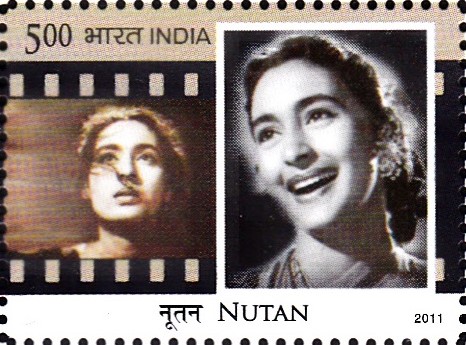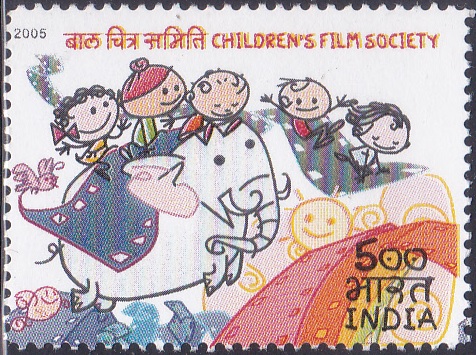
Bimal Roy
A commemorative postage stamp on the Death Anniversary of Bimal Roy, a Bengali Indian film director :
 Issued by India
Issued by India
Issued on Jan 8, 2007
Issued for : The Department of Posts is indeed privileged to issue a commemorative postage stamp on Bimal Roy.
Credits :
Stamp & FDC : Bharati Mirchandani
Cancellation : Alka Sharma
Type : Stamp, Mint Condition
Colour : Multi Colour
Denomination : 500 Paise
Stamps Printed : 0.4 Million
Printing Process : Wet–offset
Printer : Security Printing Press, Hyderabad
Name : Bimal Roy
Born on Jul 12, 1909 at Suapur, Dhaka district, Eastern Bengal & Assam, British India [now in Bangladesh]
Died on Jan 8, 1966 at Bombay, Maharashtra, India
About :
- The name of Bimal Roy is one well known and loved among film lovers, and is synonymous with good cinema. Rooted in reality, his cinematic masterpieces like ‘Udayer Pathey’ (Bengali), ‘Do Bigha Zameen’, ‘Devdas’ and ‘Bandini’ (Hindi) portray life with a rare sensitivity and a distinctive poetic sensibility. Speaking with a characteristically quiet yet resonating voice his films capture the essence of the human condition, with its drama and romance and pathos, while celebrating the dignity of the human spirit. Subtle yet telling in his indictment of social inequities and injustice, economic exploitation and human suffering, this master storyteller weaves a magic that enthralls us even today.
- Born into an affluent landowning family, the seventh of nine children of Smt. Kironmoyee and Shri Hem Chandra Roy, in village Suapur, a suburb of Dhaka, in erstwhile East Bengal, Bimal Roy was educated at Dhaka’s famous Jagannath College. Circumstances forced him to forge his own way from a very young age, and the world of cinema beckoned. Starting out as a still photographer, he soon became assistant to the eminent film-maker Nitin Bose, who was to become his mentor. From skilled cinematographer to director, and then producer, was a journey that began for Roy in New Theatres, Calcutta. He soon built up such a reputation that he was given pride of place as cinematographer on the billboards of P.C. Barua’s landmark film ‘Mukti’, along with the illustrious star cast.
- As he honed his craft, Bimal Roy’s sensitivity to the myriad forms of socio-economic oppression grew ever more acute. He joined the Indian People’s Theatre Association (IPTA) and made the astonishingly assured, bravely path-breaking film, ‘Udayer Pathey’. The film celebrated a principled fight against exploitation and was inspirational for a young and restless generation searching for a cause, among them Satyajit Ray, Ritwik Ghatak, and Mrinal Sen. The film was remade by him in Hindi as ‘Humrahi’, and was to become a clarion call of the progressive movement.
- Migrating to Bombay in 1950, at the invitation of Bombay Talkies, Roy went on to make some of his most memorable films under its banner. Among these was ‘Do Bigha Zameen’, which shows the plight of Shambhu Mahato, uprooted from his patch of land to swell the ranks of the migrant labourers in Kolkata. Influenced by Rossellini and De Sica, there is a raw and contemporary edge to the portrayal of the indomitable and proud Shambhu. In his making of ‘Devdas’, Roy remained faithful to the spirit and text of the great literary classic. Yet the master film-maker’s eye found not only the visual equivalent for the written word, but often went beyond to forge images that linger on in our collective consciousness. Thus the train becomes a symbol of the wandering hero’s journeys far away from home, a means of uprooting an individual and alienating him from his familiar moorings. The beautiful and proud Paro, whose sense of self-esteem is so typical of the strong women portrayed in Bimal Roy’s films, remains one of the most charismatic and memorable feminine characters of Hindi cinema. Kalyani, the protagonist of ‘Bandini’ remains another such archetypal figure. Who can forget the first sighting of Kalyani, as she emerges from a group of women prisoners, like a statue come to life. It was a truly virtuoso fusion of art and craft, of sound and image, which makes ‘Bandini’ such a haunting classic, and its music, including the rough velvet, lament of “O mere majhi”, continue to echo down the corridors of time.
- Bimal Roy died in 1966. But his legacy lives on, through his cinema. Born out of a unique personal vision his films speak to us today with as fresh a voice as when made, in the manner of the true classics that remain relevant for all people and for all times.
- Text : Based on material written by Smt. Maithali Rao.








[…] to films by her mother, Shobhana Samarth, in Hamari Beti. Her screen image was moulded by Bimal Roy (Sujata, Bandini) and by those who continued in the Roy tradition: Hrishikesh Mukherjee (Anari), […]
[…] Her main persona was constructed through movies like Kamal Amrohi‘s ‘Daera‘, Bimal Roy‘s ‘Yahudi‘ and Guru Dutt‘s ‘Sahib Bibi Aur Ghulam‘, […]